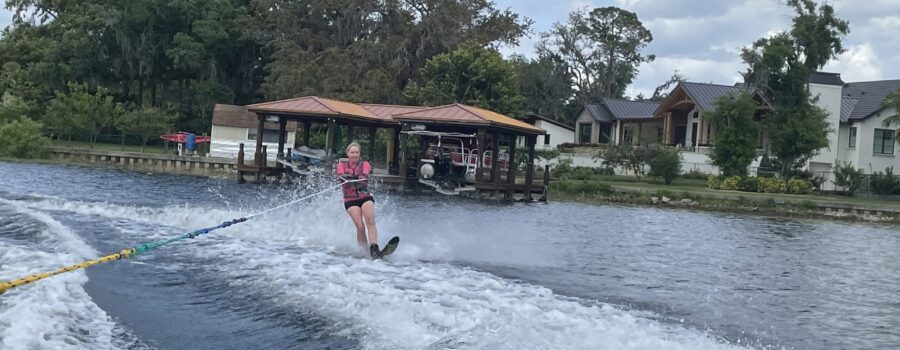By Melody Marler
Waterskiing is not just for the young, and I’m here to offer living (and sometimes limping) proof.
Today, ageless waterskiers continue to make waves, proving that age is just a number when it comes to gliding across the water with speed and style. I learned to waterski in my fifties, and within six months was crossing the wake on two skis and soon skiing the “mini course” on a slalom ski.
Inspiring Ageless Waterskiers
Waterskiing is a sport that attraccts athletes who refuse to let age slow them down. Some notable ageless waterskiers include Sammy Duvall, a waterskiing legend and six-time World Champion. Duvall remains active in the sport, now coaching and inspiring skiers of all ages. He’s a prime example of how you can continue to enjoy the sport at any age. Kris LaPoint’s waterskiing career spans more than 40 years. He is not just a legend in the sport but also a testament to longevity. He continues to train and compete, embodying what it means to be an ageless athlete. And of course we can’t forget the famous “Banana George” Blair, who started waterskiing in 1953 after he had surgery to correct a crippling back condition. According to his family, he spent his 40s through a third of his 90s touring the world as an ambassador of barefoot waterskiing. He got the name “Banana George” due to his signature bright yellow ski suits.
These skiers, and many others, show that waterskiing is not about how old you are; it’s about how you maintain your passion, fitness, and love for the sport. In this article, I’ll share some of the best exercises to keep you fit and active to enjoy waterskiing for a lifetime.
Personally…
Growing up in the landlocked high desert of Idaho, there wasn’t a lot of opportunity for watersports. I had tried to waterski once in my teens at a lake (gravel pit) fed by the Snake River. We were on a church youth group outing, and one of the dads brought his boat and a bunch of skis. Some of the kids were quite good at it. I was extremely self-conscious as a teen, so when my turn came, I only tried twice to get up on the skis. I loved being in the water and really wanted to ski. But I was uncomfortable failing in the spotlight, and I tossed in the rope.
The next time I attempted to waterski was some 20 years later at a family reunion, when my children were small. Again, having absolutely no idea how to get up out of the water on skis, I failed—although I tried more than twice this time.
Decades later, when the waterskiing-obsessed man I was dating after moving to Florida asked if I wanted to learn to ski, of course I said, “Uh, no. Not really. I haven’t been able to do it.” But he and his skiing friends talked me into giving it a try—after convincing me there were no gators in the small lake where he lived. (Yes, I do know there are alligators in every single body of water in Florida, but I was on a mission.) I’d recently been training for a sprint triathlon, so I was physically very strong and decided to give it a go.

They put a boom on the side of his boat, which they explained was easier than trying to get up with a rope. I jumped in and strapped on my skis, and grabbed the boom. The boat driver took off slowly as a companion coached me from the passenger seat. “Hold your arms straight out in front of you!” and, “Don’t let go!” As I emerged from the water and began to plane over the waves, I was hooked.
The Best State for Waterskiing? Florida
When it comes to waterskiing, no place does it better than Florida. Long known as the waterski capital of the world, Florida offers warm weather, calm waters, and numerous ski schools, making it the perfect destination for both amateurs and seasoned skiers. But with famous spots like Orlando, Winter Garden, Winter Haven, and Clermont, it’s no surprise that many of the sport’s top athletes either train or live in Florida.
Florida’s year-round ski season, smooth lakes, and vibrant waterskiing community provide endless opportunities to hit the water. Whether you’re looking to practice your slalom or just enjoy a sunny day on the lake, Florida’s welcoming waters make it the ultimate playground for skiers of all ages.
Yes, there are gators in our lakes. Before I go waterskiing, typically I’ll ask the boat driver to make a lap at full speed around the lake or at least in the area I’ll be dropping into, as I’ve been told the loud motor of the ski boat scares the gators out of the way. And I never get into the water near the edge or in the weeds. That’s where the gators—and snakes—enjoy hanging out. Signal your driver for a quick pick up when you’re finished skiing, and don’t fall!
Staying Strong and Flexible for Waterskiing
After a few ski outings, I realized the importance of stretching and warming up even before waterskiing. It looks effortless, but it requires tremendous upper body strength for endurance. And to continue skiing as you age, staying strong and flexible is crucial. Waterskiing demands balance, core strength, and agility; maintaining these attributes will help you enjoy the sport longer while minimizing the risk of being hurt.
Here are some key exercises that will keep your body in tune for waterskiing, helping you stay fit and agile on the water.
Recommended Exercises for Ageless Waterskiers
Use a foam roller. Roll out your muscles with a roller before skiing. I roll my thighs, calves, hips, arms, and ankles with a Rollga, and my feet with a tennis ball.
Release foot tension. Use a tennis ball to release tension in your feet. Place the tennis ball underneath your foot and roll it back and forth as well as to the top of your foot (underneath your toes) and back to underneath your heel. Press down moderately at various points as you roll.
Ankle raises. From a standing position, keep your toes planted while you lift and lower your heels several times. This movement will strengthen your ankles and help you maintain flexibility.
Plank. The plank is a great exercise for building core strength and stability, essential for maintaining balance on skis.
- Start in a push-up position with your forearms on the ground, elbows directly beneath your shoulders, and your body forming a straight line from head to heels.
- Keep your core engaged by pulling your belly button towards your spine and avoid letting your hips sag or rise.
- Hold this position, focusing on keeping your back flat and breathing steadily.
- Start with holding for 20-30 seconds and gradually increase the time as your core strengthens.
Side Plank. The side plank focuses more on the obliques, which are essential for rotational movements in waterskiing.
- Lie on your side with your legs stacked and one forearm on the ground directly below your shoulder.
- Lift your hips off the ground so your body forms a straight line from head to feet.
- Keep your core engaged and hold for 20-30 seconds, then switch to the other side.
- As you progress, aim to hold each side for longer durations.
Squats and Lunges. Squats and lunges are fundamental exercises for building leg strength, crucial for holding your stance and absorbing impact on the water.
Squats
- Stand with your feet shoulder-width apart, toes slightly pointed outward.
- Engage your core and keep your chest up as you lower your body by bending your knees and pushing your hips back, as if sitting in a chair.
- Lower until your thighs are parallel to the ground or as far as your mobility allows.
- Press through your heels to return to the starting position.
- Perform 3 sets of 10-15 repetitions.
Lunges
- Stand tall with your feet together and hands on your hips or by your sides.
- Step forward with one leg and lower your body until both knees are bent at a 90-degree angle, keeping your front knee directly above your ankle.
- Push through your front heel to return to the starting position.
- Alternate legs and repeat, aiming for 10-15 reps per leg for 3 sets.
Resistance Band Rotations. These will strengthen your core, especially your obliques, enhancing your ability to twist and turn on the water.
- Attach a resistance band to a sturdy anchor point at chest height.
- Stand sideways to the anchor point, holding the band with both hands extended in front of you.
- Engage your core and rotate your torso away from the anchor point, keeping your arms straight and resisting the band’s pull.
- Slowly return to the starting position.
- Perform 10-15 rotations on each side for 3 sets.
Shoulder Press and Rows build the upper body strength necessary to maintain a strong grip on the tow rope.
Shoulder Press
- Stand with your feet shoulder-width apart, holding a dumbbell in each hand at shoulder height with palms facing forward.
- Engage your core and press the dumbbells overhead until your arms are fully extended.
- Lower the weights back to shoulder height with control.
- Aim for 3 sets of 10-12 repetitions.
Rows
- Stand with your feet hip-width apart, holding a dumbbell in each hand, palms facing your body.
- Hinge at your hips, keeping your back straight and core engaged.
- Pull the weights towards your hips, squeezing your shoulder blades together.
- Slowly lower the weights back down and repeat for 3 sets of 10-12 reps.
Balance Drills. One of the essential exercises to train for waterskiing, balance drills mimic the unpredictable movements on the water.
Balance Board
- Stand on a balance board or a wobble cushion, keeping your feet shoulder-width apart.
- Try to maintain your balance for 30-60 seconds, engaging your core and adjusting your weight as needed.
- To increase the difficulty, perform squats or other movements while balancing.
Single-Leg Balance
- Stand on one foot, keeping your core engaged and your gaze focused on a spot ahead.
- Hold for 20-30 seconds, then switch legs.
- To make it more challenging, close your eyes or add slight movements with your arms.
Yoga or Pilates Poses. Yoga and Pilates improve flexibility, balance, and overall body control, which are essential for the dynamic movements in waterskiing.
Key Poses for Flexibility and Strength
Downward Dog
- Start on your hands and knees with your wrists under your shoulders and knees under your hips.
- Press into your hands, lift your knees, and extend your legs, bringing your hips towards the ceiling to form an inverted “V” shape.
- Keep your spine straight and your heels pressing towards the ground. Hold for 20-30 seconds.
Warrior Pose
- Stand with your feet wide apart. Turn your right foot out 90 degrees and your left foot slightly in.
- Bend your right knee over your ankle, keeping your left leg straight and strong.
- Raise your arms parallel to the ground, palms facing down, and gaze over your right hand. Hold for 20-30 seconds before switching sides.
Tree Pose
- Stand tall with your feet together. Shift your weight onto your left foot and bring your right foot to rest on your inner left thigh or calf (avoid the knee).
- Bring your hands together in front of your chest or raise them overhead.
- Focus on a spot in front of you for balance and hold for 20-30 seconds before switching sides.
Waterskiing is a sport that doesn’t have to end with age. By staying active and maintaining strength and flexibility, you can continue to carve up the water for years to come. Remember, it’s not about your age—it’s about how you keep yourself prepared, both mentally and physically, to enjoy every moment on the water.




